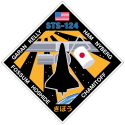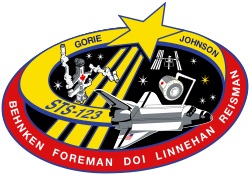Garrett Reisman
| Garrett Reisman | |
|---|---|
 | |
| NASA Astronaut | |
| Statsborger | USA |
| Nationalitet | Amerikansk |
| Status | Aktiv |
| Født | 10. februar 1968 Alder 53 Morristown, New Jersey |
Andet arbejde | Ingeniør |
| Uddannelses- sted | California Institute of Technology University of Pennsylvania |
| Rang | Ph.d. |
Tid i rummet | 95d 08t 47m |
| Udvælgelse | NASA-gruppen fra 1998 |
| Mission(er) | NEEMO, STS-123, Ekspedition 16 & 17, STS-124, STS-132 |
| Missionsemblemer | |
| Hjemmeside | Garrett Reismans hjemmeside |
Garrett Erin Reisman (født 10. februar 1968) er en NASA-astronaut der har været to gang i rummet – inklusiv to halve rumfærge-missioner.
Han har tidligere opholdt sig i 2 uger i et undervandslaboratorium NEEMO i 2003, der minder om forholdene om bord på en rumstation.[1]
Garrett Reisman kom op til Den Internationale Rumstation med STS-123 Endeavour d. 13. marts 2008 hvor han afløste Léopold Eyharts som besætningsmedlem på ISS Ekspedition 16. I april 2008 skiftede han til ekspedition 17 da Peggy Whitson og Jurij Malentjenko (eksp. 16 stambesætning) blev afløst af Sergej Volkov og Oleg Kononenko (eksp. 17 stambesætning).
Den 2. juni 2008 afløste Reisman Gregory Chamitoff, Reisman returnerede med STS-124 Discovery 14. juni 2008.
Eksterne henvisninger
- NASA Biografi af Garrett Reisman (engelsk)
- interview STS-123 (engelsk)
Noter
- ^ "Neemo 5". Arkiveret fra originalen 29. august 2012. Hentet 5. marts 2008.
Medier brugt på denne side
ISS016-S-001A (February 2007) --- This patch commemorates the sixteenth expeditionary mission to the International Space Station (ISS). The design represents the conjunction of two unique astronomical events: a transit of the ISS across the surface of a full moon, and a nearly complete annular eclipse of the sun. The ISS is shown in its complete configuration, symbolizing the role of this expedition in preparing for the arrival and commissioning of international partner modules and components. The ISS transit across the moon highlights its role in developing the techniques and innovations critical to enable long-duration expeditions to the lunar surface and beyond. The NASA insignia design for shuttle and space station flights is reserved for use by the astronauts and for other official use as the NASA Administrator may authorize. Public availability has been approved only in the form of illustrations by the various news media. When and if there is any change in this policy, which is not anticipated, it will be publicly announced.
The Expedition 17 patch is meant to celebrate current human achievements in space as well as symbolize the future potential for continuing exploration. The Earth, represented at the bottom of the patch, is the base from which all space exploration activities initiate. The International Space Station (ISS), shown in low Earth orbit, illustrates the current level of space operations. The arrow and star point outwards, away from the Earth, towards the wider universe indicating the direction of future activities as human beings build on what has already been accomplished. The flags, representing the home countries of the crew members, Russia and the United States, are touching, highlighting the cooperative nature of the space program and symbolizing the merger of science and technical knowledge of these two experienced space-faring nations.
portrait astronaut Garrett Reisman
The STS-132 mission will be the 32nd flight of the space shuttle Atlantis. The primary STS-132 mission objective is to deliver the Russian-made MRM-1 (Mini Research Module) to the International Space Station (ISS). Atlantis will also deliver a new communications antenna and a new set of batteries for one of the ISS solar arrays. The STS-132 mission patch features Atlantis flying off into the sunset as the end of the Space Shuttle Program approaches. However the sun is also heralding the promise of a new day as it rises for the first time on a new ISS module, the MRM-1, which is also named Rassvet, the Russian word for dawn.
Emblem of Nasa's STS-124 mission.
- The STS-124/1J patch depicts the Space Shuttle Discovery docked with the International Space Station (ISS). STS-124/1J is dedicated to delivering and installing the Japanese Experiment Module (JEM) known as Kibo (Hope) to the ISS. The significance of the mission and the Japanese contribution to the ISS is recognized by the Japanese flag depicted on the JEM Pressurized Module (JPM) and the word Kibo written in Japanese at the bottom of the patch. The view of the sun shining down upon the Earth represents the increased "hope" that the entire world will benefit from the JEM's scientific discoveries. The JPM will be the largest habitable module on the ISS and is equipped with its own airlock and robotic arm for external experiments. In addition to delivering and installing the JPM, the STS-124 crew will relocate the JEM Logistics Pressurized (JLP) module to its permanent home on the zenith side of the JPM. During three planned space walks, the crew will perform external ISS maintenance and JPM outfitting, as well as extensive robotic operations by the ISS, space shuttle, and JEM robotic arms. It will be the first time that three different robotic arms will be operated during a single space flight mission.
STS-123 continues assembly of the International Space Station (ISS). The primary mission objectives include rotating an expedition crew member and installing both the first component of the Japanese Experimental Module (the Experimental Logistics Module - Pressurized Section (ELM-PS)) and the Canadian Special Purpose Dexterous Manipulator (SPDM). In addition, STS-123 will deliver various spare ISS components and leave behind the sensor boom used for inspecting the shuttle's thermal protection system. A follow-on mission to ISS will utilize and then return home with this sensor boom. A total of five spacewalks are planned to accomplish these tasks. The mission will also require the use of both the shuttle and ISS robotic arms. STS-123 will utilize the Station-Shuttle Power Transfer System to extend the docked portion of the mission to eleven days, with a total planned duration of 15 days. The crew patch depicts the space shuttle in orbit with the crew names trailing behind. STS-123's major additions to ISS (the ELM-PS installation with the shuttle robotic arm and the fully constructed SPDM) are both illustrated. The ISS is shown in the configuration that the STS-123 crew will encounter when they arrive.






